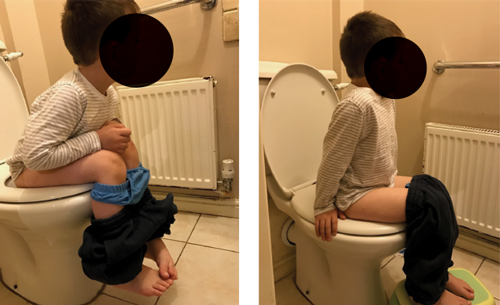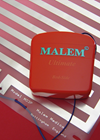It is estimated that daytime wetting affects one in seventy-five children over the age of five years [1]. Daytime wetting is commoner in younger children (1 in 7 aged 4.5 years, 1 in 20 aged 9.5 years) [1]. Many younger children and their parents accept the occasional accident following potty training. However, as children become older and start school, the consequences of wetting can be more serious, with children becoming anxious or avoiding social events such as visiting friends, or suffering name calling or bullying from other children.
History of presenting complaint
The aim of assessment is to identify or exclude any organic causes and to advise on appropriate treatment. The first step in the assessment of wetting is to take the history. Reassure the child and parents that wetting is common and there is no need to be embarrassed to talk about it. Take as much of the history as possible directly from the child with parents to clarify if necessary. Parents may be surprised to learn that their child’s voiding habits at school may be very different from those at home! Points to cover in the history are:
- How often does the wetting occur – is it every day?
- Has the child ever been dry for a period of six months or more?
- Incontinence in a person who has never been dry for six months is called primary incontinence.
- If the child has previously been dry (secondary incontinence) the likelihood of an organic cause for the wetting is less common. - When does the wetting occur?
- If a girl wets shortly after voiding it suggests there may be reflux of urine into the vagina and a change of voiding posture may alleviate the wetting.
- Does the wetting occur when the child is distracted or tired
– if so techniques such as timed voiding can be helpful.
- If the wetting only occurs when the child laughs, this is diagnostic of giggle incontinence. Giggle incontinence usually affects girls and most will grow out of it without any specific treatment. - When the wetting occurs, how much urine comes away (is it the whole bladder volume, needing a complete change of clothes or just a little dribble onto pants?)
- Is the wetting continuous?
- In a child with a continuous urinary trickle, there is a high probability that there will be an underlying anatomical or neurological abnormality such as an ectopic ureteric orifice. - How often does the child pass urine?
- I find it helpful to talk the child though their day (at school and at home if necessary) as this will be more informative that simply the number of voids. For example, does the child go to the toilet at break and lunch time at school? Does (s)he have a ‘toilet pass’ to be excused from lessons? Does (s)he use the toilets at school (and if not why not)? I have heard reports of children avoiding school toilets because they are “yucky”, because of bullying (or the fear of bullying) and even because of “an alligator” who lives in the school plumbing. Whilst some of these reasons may sound ridiculous to an adult, the fears may be very real to the child and should be addressed sensitively. - Is there any associated urgency?
- Is the flow continuous or staccato?
- Staccato flow is suggestive of dysfunctional voiding (previously known as Hinman syndrome or non-neurogenic neurogenic bladder). This is when the external urethral sphincter contracts during voiding. There are a number of recognised causes including learned behaviour patterns [2]. - Does the child ever try to put off going to the toilet?
- In simple terms, most children find going to the toilet less interesting than most other activities and so may try to defer this for as long as possible, increasing the chances of wetting when the void can no longer be deferred. Parents may report a girl sitting on her heels (Vincent’s curtsey). This history of deferred voiding is very common in functional wetting and may be a surprise to the parents. - Is the child dry at night?
- What, how much and when does the child drink?
- Just as in adults assess for consumption of bladder irritants such as caffeine containing drinks, fizzy drinks or blackcurrant juices. Also note any very large or very small fluid intake as both can contribute to wetting. Are drinks spread throughout the day or taken in a rush when a child who has avoided or not been permitted drinks at school gets home? - Check bowel function. Is the child constipated? Is there faecal soiling as well as wetting?
- Treating constipation will improve bladder symptoms.
- Persisting double incontinence raises the likelihood of neuropathic bladder and bowel pathology. - Are there any symptoms to suggest urinary tract infection (UTI)? Is there a history of proven UTI?
- If the child had previously been dry, were there any significant events (such as new school, new sibling) that occurred around the same time?
- If the child had previously been dry, enquire about the age and ease of potty training.
The history should also cover any co-morbidies such as diabetes, any medication that the child is currently on or has previously tried for the wetting. Family history may be of relevance (bedwetting seems to be more common and persist to a later age if there is a family history). Social history is important in the paediatric population – who does the child live with and do they attend mainstream school? Are there any behavioural or psychosocial problems?
“A good history is key to the diagnosis supported by thorough physical examination to exclude organic causes.”
Examination
Observe the child’s gait as (s)he walks into the consultation room and to the examination couch as this may be the first clue to a neurological problem. Examine the abdomen for a distended bladder and palpable kidneys which may suggest outflow obstruction. Examine the external genitalia. In boys you may see evidence of epispadias or hypospadias, pathological phimosis or meatal stenosis. In girls look for epispadias (may have bifid clitoris), common urogenital sinus and imperforate hymen. It is rare to see an ectopic ureter on general examination but occasionally urine can be seen trickling from an ectopic ureteric orifice. Examine the spine for a hairy patch, lipoma, cutaneous haemangiomata or sinuses (which may suggest neurological causes of wetting). Flattening of the buttocks is clinically suggestive of sacral agenesis. Examine the lower limbs and feet for evidence of muscle wasting or deformity and check reflexes and cutaneous sensation. The presence or absence of peri-anal sensation should also be recorded.
Investigation
It is helpful for the child / family to complete a bladder diary (ideally before the appointment so it can be reviewed at the first assessment). Urinalysis will reveal glycosuria, proteinuria and UTI. Uroflowmetry can be used as in adults to assess urinary flow. It is estimated that 99% school age children will have a normal bell shaped curve with only 1% having an abnormal or flattened curve [3].
Ultrasound assessment of post void residual (PVR) may suggest either outflow obstruction or neuropathic bladder. PVR should be less than 10% of expected bladder capacity (expected bladder volume (ml) = [age+1] x 30). In selected cases ultrasound of the upper tracks may be requested to exclude hydronephrosis or duplex kidneys). A small minority of children with wetting will proceed to video-urodynamics; this invasive investigation is generally reserved for those children suspected to have neurogenic bladder or sphincter dysfunction, or where a clinical diagnosis is elusive. It is preferable to have a play therapist as part of the team to help the child understand and prepare for the urodynamics and to be present along with the child and family during the test. MRI spine is indicated in children with clinical suspicion of spinal lesion (depending on the age and maturity of the child this may require general anaesthesia).
Causes of wetting
- UTI
- Overactive bladder syndrome (OAB)
- As in adults, a syndrome of urgency with or without urge urinary incontinence, usually with frequency and nocturia. - Stress urinary incontinence (SUI)
- The leak of urine associated with raised intra-abdominal pressure.
- SUI in children is associated with cystic fibrosis [4] but is otherwise rare except with a neuropathic bladder. - Giggle incontinence
- Almost exclusively seen in girls.
- Presents with urinary incontinence triggered by laughter and otherwise normal bladder function.
- Generally self-limiting with increasing age (but can persist until mid-teens). - Neuropathic bladder - Neuropathic bladder is more likely if there is constant dribbling of urine or abnormal bowel function (especially soiling) or the bladder is expressible.
- Vaginal reflux of urine
- This is most commonly due to poor toileting posture where urine refluxes into vagina on voiding and leaks onto underwear when the girl stands up. It can also be secondary to labial adhesions, which can be managed using topical oestrogen cream or division of adhesions. - Ectopic ureter (insertion distal to sphincter).
- Dysfunctional voiding.
- Exstrophy / epispadias.
- Sexual abuse should be considered as a potential cause in children presenting with new onset of wetting [5,6].
Treatment
The majority of children with daytime wetting can be managed conservatively. Reassurance and education for both the child and the family are vital.
I advise all children referred with wetting to avoid bladder irritants (fizzy drinks, blackcurrant juices and caffeine containing drinks), and to aim for six to eight cups of water or milk based fluids per day. Some families are very reluctant to provide this amount of fluid for the child, fearing it will make the wetting worse; it is therefore important to explain that the bladder needs to be ‘re-taught’ how to fill and empty and by having a healthy fluid intake, the bladder will be encouraged to fill to its expected capacity rather than get into a ‘bad habit’ of wanting to empty at small volumes. Along with this, I advise timed voiding in order to avoid urgency and possible wetting associated with voiding deferment [7]. A star chart may provide motivation for the child to comply with timed voiding and serve as a visual record of progress. Constipation should be managed with diet, a healthy fluid intake and laxatives (such as lactulose) if required.
Where the wetting occurs immediately or soon after voiding, encourage the child to take his or her time voiding rather than rush. Boys should be encouraged (if possible) to pull back the foreskin when voiding to avoid drops being caught under the prepuce or if there is ballooning of the foreskin with a physiological phimosis encourage the boy to wait until all of the urine drains out and shake the penis to remove any drips after micturition. Girls may need to change their voiding posture if there is reflux of urine into the vagina. Classically girls with vesicovaginal refux sit forward on the seat with legs together and torso tilted forward. Obseity may be a factor [8].
The International Continence Society (ICS) advises that a detailed description of the child’s voiding posture is obtained, or preferably observed. If a young child adopts an awkward voiding posture, this may impair proper relaxation of the pelvic floor and so impede micturition (Figure 1).

Figure 1: The photograph on the left shows a child with incorrect voiding posture. The feet are not supported and are dangling in the air, making pelvic floor relaxation difficult. The photograph on the right shows a simple step supporting the feet, allowing the pelvic floor to relax. This posture should be adopted for micturition and defaecation.
In my practice, in addition to advising on the topics listed earlier, I direct the family to the ERIC website (www.eric.org.uk) which provides free of charge independent information and advice. Leaflets for parents and children can be downloaded from the website and there are separate message boards for parents and children where they can share their experiences with others in a similar situation. Some families find this peer support very beneficial.
Where conservative measures have not been sufficient to produce continence, medication can be trialled. When discussing medication use in children it must be remembered that relatively few medications are licensed for use in children and it is common in paediatric practice to make use of ‘off-licence’ medications. In these cases it is important to discuss this and the rationale for the use of this medication with the child (if they are old enough to make treatment decisions) and the parents.
Anticholinergics are the mainstay of pharmacotherapy for wetting. Oxybutyin is licensed for use in children. Solifenacin is not currently licensed for use in children, however there is evidence that solifenacin is efficacious and well tolerated in children who previously have had treatment failure or side-effects with other anticholinergics. The dose of solifenacin used in trials varied from 1.25-10mg [9]. Other researchers used a standard 5mg dose [10].
Mirabegron (Betmiga) is a first in class β3-adrenoreceptor agonist. Mirabegron is not currently licensed in children; however, there is evidence for its use in children who previously failed treatment with at least two anticholinergics [11].
Desmopressin is licensed to treat nocturnal enuresis but has no role in the treatment of daytime wetting.
Conclusion
Daytime wetting is common in children and can cause considerable distress to children and their parents. A good history is key to the diagnosis supported by thorough physical examination to exclude organic causes. Many children can be managed conservatively with education and behaviour modification.
Take home message
-
Divide childhood incontinence into primary (never been dry for more than six months) and secondary (previously dry for six months or more).
-
A good history is key to understanding the pattern of voiding and associated issues. Include bowel function in the history.
-
Clinical examination is essential to exclude an anatomical or neuropathic cause.
-
Most childhood wetting will respond well to lifestyle modification and education.
-
Oxybutynin is licensed for use in children.
-
Use invasive testing sparingly in children and only when the results will alter your management.
FURTHER READING
Reynard J, Brewster S, Biers S. Oxford Handbook of Urology 3rd Edition. Oxford, UK; Oxford University Press: 2013.
Thomas DFM, Rickwood AMK, Duffy PG. Essentials of Paediatric Urology. London, UK; Martin Dunitz: 2002.
References
1. Education and Resources for Improving Childhood Continence (ERIC). www.eric.org.uk
2. Chase J, Austin P, Hoebeke P, McKenna P. The Management of dysfunctional voiding in children: a report from the standardisation committee of the International Children’s Continence Society. Journal of Urology 2010;183:1296-302.
3. Mattson S, Spangberg A. Urinary flow in healthy school children. Neurourol Urodyn 1994;13:281-96.
4. Nixon GM, Glazner JA, Martin JM, Sawyer SM. Urinary incontinence in female adolescents with cystic fibrosis. Pediatrics 2002;110(2):e22.
5. Bloom DA. Sexual abuse and voiding dysfunction [editorial]. J Urol 1995;153:777.
6. Ellsworth PI, Merguerian PA, Copening ME. Sexual abuse: another causative factor in dysfunctional voiding. Journal of Urology 1995;153(3 Pt 1):773-6.
7. Allen HA, Austin JC, Boyt MA, et al. Initial trial of timed voiding is warranted for all children with daytime incontinence. Urology 2007;69(5):962-5
8. 4th International Consultation on Incontinence. Evaluation and Treatment of Urinary Incontinence, Pelvic Organ Prolapse and Faecal Incontinence. 2009.
www.ics.org/publications/
ici_4/files-book/recommendation.pdf
Accessed November 2016.
9. Bolduc S, Moore K, Nadeau G, et al. Prospective Open Label Study of Solifenacin for Overactive Bladder in Children. The Journal of Urology 2010;184(4):1668-73.
10. Hoebeke P, De Pooter J, De Caestecker K, et al. Solifenacin for Therapy Resistant Overactive Bladder. The Journal of Urology 2009;182(4):2040-4.
11. Blais A-S, Nadeau G, Moore K, et al. Prospective pilot study of Mirabegron in Paediatric patients with overactive bladder. European Urology 2016;70(1):9-13.
Declaration of competing interests: None declared.






